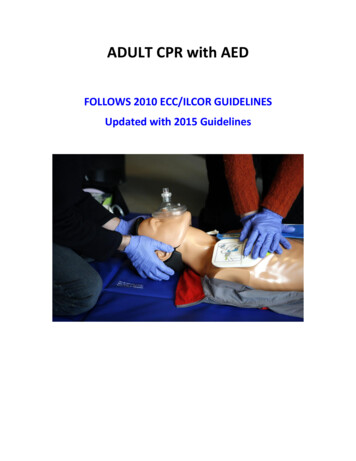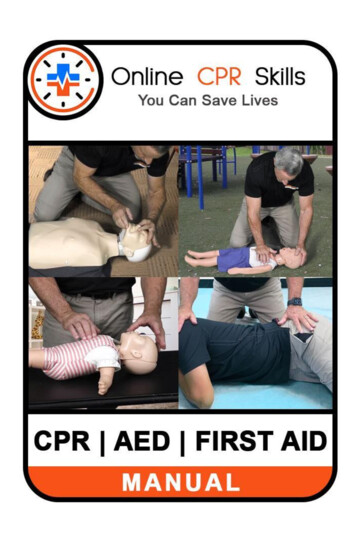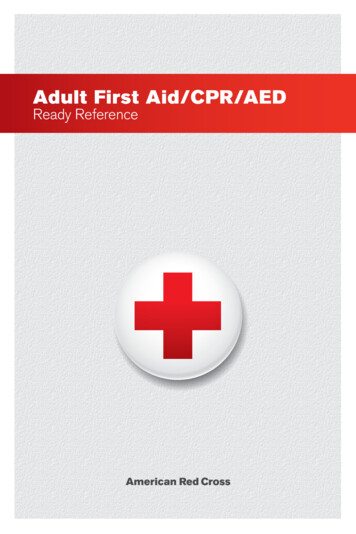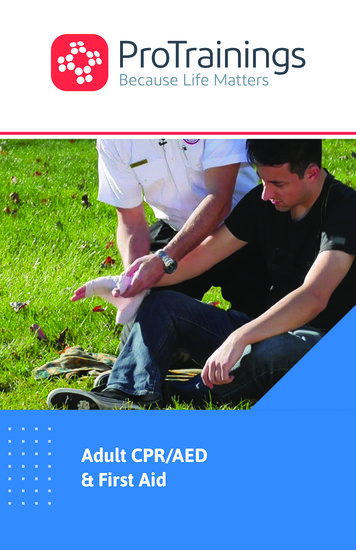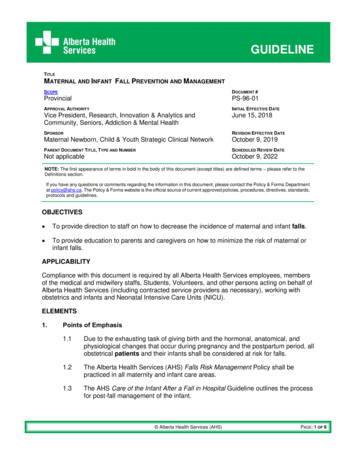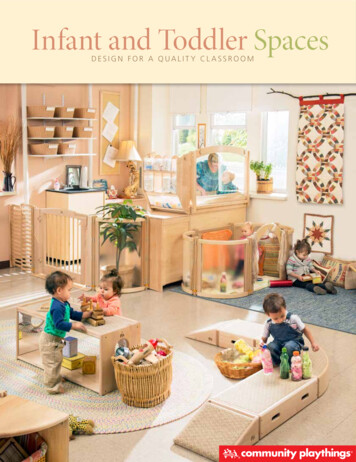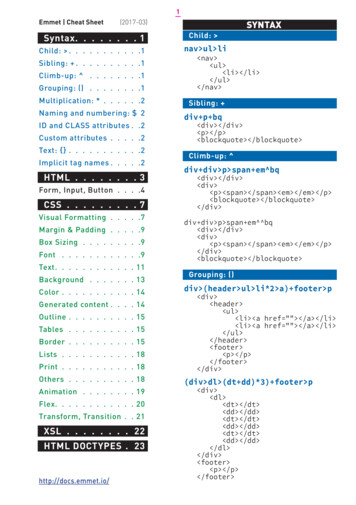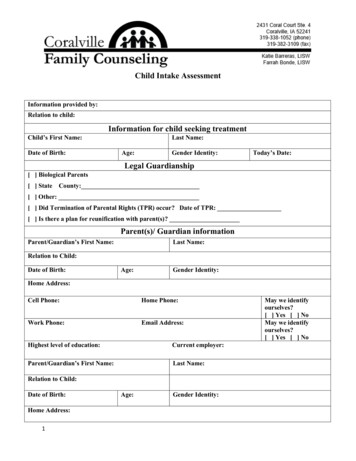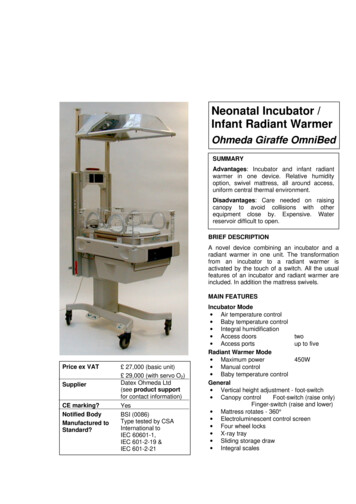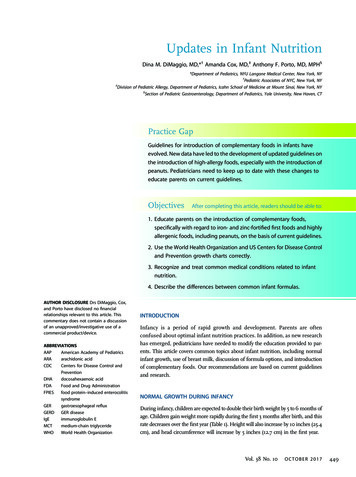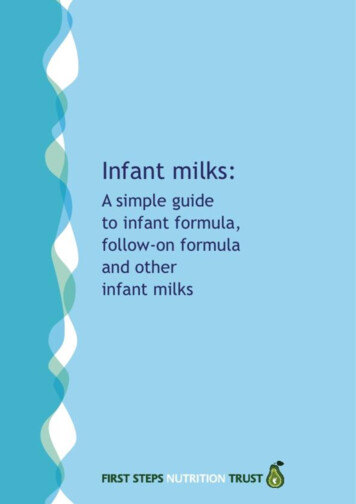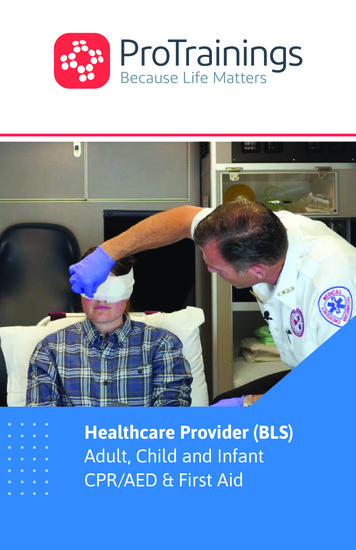
Transcription
Healthcare Provider (BLS)Adult, Child and InfantCPR/AED & First Aid
The purpose of this booklet is to provide a brief review of course content fora specific ProTrainings course.Visit www.protraininings.com to view the full course curriculum. This material is powered by the ProTrainings. All content 2021, ProTrainings, LLC. All rights reserved.Revised: May 2021
COURSE CONTENT04Overcome the 5 fears that prevent rescue27Concussions05Prevention of cardiovascular disease28Musculoskeletal Injuries06Recognition and action steps forsuspected heart attack and stroke29Burns29Eye Injuries30Diabetic Emergencies30Seizures30Poison Control31Bites and Stings31Allergic Reactions32Asthma07Universal Precautions07Use of a resuscitation mask08CPR for adult, child and Infant14AED for adult, child and Infant17Use of a Bag Valve Mask18Two rescuer CPR for adult, child and infant21Conscious and unconscious choking foradult, child and infant32Epinephrine Injection24Bleeding Control33Heat and Cold Emergencies25Shock Management35Special Considerations25Secondary Survey37Opioid Overdose27Head, Neck and Back Injuries38Moving PeopleBASIC TERMSGood Samaritan Law states that a personacting in good faith, rendering reasonable first aid,will not be held accountable for damages to thatperson unless gross willful misconduct is used. Thisperson must not have a legal duty to respond orcomplete the first aid.Negligence When you have a duty to respondand you fail to provide care or give inappropriatecare, and your failure to provide care or inappropriate care causes injury or harm.Universal Precautions Using gloves, masks,Consent a patient allowing you to give first aidgowns, etc. for every patient every time when there isa possibility of coming in contact with any body fluids.Informed consent you informing the patientClinical Death The moment breathing andof consequences, and then the patient givingpermission for you to give first aid.Implied consent when a patient isunconscious, it is given that if the person wereconscious, they would request care.Abandonment initiating care and then stopping without ensuring that the person has samelevel or higher care being rendered.heartbeat stop. Typically, a person has a highlikelihood of being revived without much cellulardamage when clinically dead for approximately 0-6minutes. Within 6-10 minutes, brain cell damage ishighly likely.Biological Death Irreversible damage tobrains cells and tissues. If a person has beenclinically dead for 10 minutes or more, therewill be irreversible cell damage. Resuscitation isunlikely but not impossible.Healthcare Provider (BLS) Adult, Child and Infant CPR/AED3
THE FIVE FEARS1 FEAR OF DISEASESolution: Universal precautions. Whenever the possibilityof coming in contact with bodily fluids exists, wear personal protective equipment for every patient, every time.2 FEAR OF LAWSUITSSolution: Good Samaritan laws. States have laws thatprotect people from legal action who act in good faith toprovide reasonable First Aid when the rescuer does nothave a legal duty to respond.3 FEAR OF UNCERTAINTYSolution: Emphasis is placed on the role of CPR not merely on the number sequences. Even if numbers are forgotten, remember to push hard and push fast. This emphasizes the simplicity of basic life support.4 FEAR OF HURTING A PATIENTSolution: Patients who are clinically dead can only behelped, not made worse with resuscitation efforts.5 FEAR OF UNSAFE SCENESolution: Never enter an unsafe scene! Rescuers are nouse to patients if they become patients themselves.Healthcare Provider (BLS) Adult, Child and Infant CPR/AED4
CARDIOVASCULAR DISEASECardiovascular disease is the number onekiller in the United States. The Center forDisease Control reports that in the UnitedStates over 650,000 people die each year fromcardiovascular disease.CONTROLLABLE RISK FACTORS cigarette smoking high blood pressure obesity lack of exercise high blood cholesterol levels uncontrolled diabetes high fat diet high stressUNCONTROLLABLE RISK FACTORS racehereditysexageCardiovascular disease causes damage to the heart and blood vessels.Cardiovascular disease often leads to heart attack or stroke. The best way to survive a heartattack or stroke is to never have one. The key for cardiovascular disease is to focus on prevention.You can give yourself the best chance of preventing cardiovascular disease with proper nutrition, consistent physical activity, weight management, stress management, eating proper fatsand oils, and quitting smoking.Healthcare Provider (BLS) Adult, Child and Infant CPR/AED5
HEART ATTACKSIGNS AND SYMPTOMS MAY INCLUDE Chest discomfort-pressure, tightness, thatmay radiate to jaw and arms. Nausea Sweating Shortness of breath Denial Feeling of weaknessWomen present more with shortness of breath,extreme fatigue, or flu-like symptoms.About a third of women experience no chest pain.TREATMENTRecognize the signs and symptoms of a heart attack, activate EMS, havepatient remain in a position of comfort, offer 1 adult dose aspirin, and keepthe patient calm and quiet.STROKEStroke is the 3rd leading cause of death in the UnitedStates. Strokes can be one of two types:ischemic a clot in a blood vessel that restricts or obstructsblood flow to the brain.hemorrhagic a blood vessel that ruptures and preventsblood flow to the brain. In either case, the brain is deprivedof oxygen and tissue starts to die. The longer the stroke goesunrecognized and untreated, the more damage is done.SIGNS AND SYMPTOMS MAY INCLUDE Numbness or weakness of the face,arm or leg, especially on one side ofthe body. The acronym FAST helps inassessing a stroke:F– facial droop, A– Arm drift, S– Speech,T– Time Confusion, trouble speaking orunderstanding Trouble seeing in one or both eyes Trouble walking, dizziness, loss ofbalance or coordination Severe headache with no known causeTREATMENTRecognize the signs and symptoms of a stroke, activate EMS, give nothing to drink or eat, andkeep the patient calm and quiet. Monitor patient and be prepared to start CPR if necessary.Healthcare Provider (BLS) Adult, Child and Infant CPR/AED6
CHAIN OF SURVIVALThe earlier these steps take place in an emergency, the better the chance of a patient’s survival.Recognition andActivation of EMSHigh Quality CPRDefibrillationAdvanced CarePost Cardiac ArrestCare and RecoveryUNIVERSAL PRECAUTIONSPUTTING GLOVES ON:Use disposable gloves when providing first aid care. If you have a latex allergy use a latexalternative such as nitrile or vinyl. Before providing care, make sure the gloves are not rippedor damaged. You make need to remove rings or other jewelry that may rip the gloves.REMOVING GLOVES:Remember to use skin to skin and glove to glove. ➊ Pinch the outside wrist of the othergloved hand. ➋ Pull the glove off turning the glove inside-out as you remove it. ➌ Hold it inthe gloved hand. ➍ Use the bare hand to reach inside the other glove at the wrist to turn itinside out trapping the other glove inside. Dispose of gloves properly. If you did it correctly,the outside of either glove never touched your exposed skin.USE A RESCUE MASK OR FACE SHIELD:If you have to provide rescue ventilations, use a rescue mask or face shield that has a oneway valve. To prevent exposure, avoid giving direct mouth to mouth ventilations.Healthcare Provider (BLS) Adult, Child and Infant CPR/AED7
RESCUE BREATHINGCHECK THE SCENEKey Questions to ask: Is it safe for me to help? What happened? How many patients are there? Am I going to need assistance from EMS? Do I have my personal protective equipmentready to use?CHECK THE PATIENTTap and shout. Is there any response?ACTIVATE EMS – CALL 911Send someone to call and tell them to come back. The caller should give dispatch thepatient’s location, what happened, how many people are injured, and what is being done.If alone and no one is available: PHONE FIRST for adults and get the AED.Return to start CPR and use the AED for allages. CARE FIRST for children and infants byproviding about 5 cycles or 2 minutes of CPRbefore activating the emergency responsenumber. CARE FIRST for all age patients of hypoxic(asphyxial) arrest (ei., drowning, injury, drugoverdose).Healthcare Provider (BLS) Adult, Child and Infant CPR/AED8
RESCUE BREATHINGCHECK PULSECheck the Circulation for no more than 10 secondsAdult and Child– Check the carotid artery in theneck.Infant– Check the brachial artery on the inside ofthe upper arm.If unsure a pulse exists, start CPR. Don’t wastecritical time searching for a pulse.While checking the pulse, look for normal breathing by looking at the person’s chest andface. Is the patient breathing normally?Agonal respirations are not normal breathing. They would be characterized as occasionalgasps. The chest does not rise.BEGIN RESCUE BREATHINGIf there is a pulse but no breathing, apply face shield and start rescue breathing. Each breathshould last 1 second.ADULT1 breath every 6 secondsCHILD1 breath every 2-3 seconds(Breaths can be given every 2-3seconds, or about 20-30 breathsper minute.)INFANT1 breath every 2-3 seconds(Breaths can be given every 2-3seconds, or about 20-30 breathsper minute.)Reassess circulation every 2 minutes. If unsure a pulse exists, start CPR.Don’t waste critical time searching for a pulse.Healthcare Provider (BLS) Adult, Child and Infant CPR/AED9
CPRCHECK THE SCENEKey Questions to ask: Is it safe for me to help? What happened? How many patients are there? Am I going to need assistance from EMS? Do I have my personal protective equipmentready to use?CHECK THE PATIENTTap and shout. Is there any response?ACTIVATE EMS – CALL 911Send someone to call and tell them to come back. The caller should give dispatch thepatient’s location, what happened, how many people are injured, and what is being done.If alone and no one is available: PHONE FIRST for adults and get the AED.Return to start CPR and use the AED for allages. CARE FIRST for children and infants byproviding about 5 cycles or 2 minutes of CPRbefore activating the emergency responsenumber. CARE FIRST for all age patients of hypoxic(asphyxial) arrest (ei., drowning, injury, drugoverdose).Healthcare Provider (BLS) Adult, Child and Infant CPR/AED10
CPRCHECK PULSECheck the Circulation for no more than 10 secondsAdult and Child– Check the carotid artery in theneck.Infant– Check the brachial artery on the inside ofthe upper arm.If unsure a pulse exists, start CPR. Don’t wastecritical time searching for a pulse.While checking the pulse, look for normal breathing by looking at the person’s chest andface. Is the patient breathing normally?Agonal respirations are not normal breathing. They would be characterized as occasionalgasps. The chest does not rise.COMPRESSIONSIf the victim is unconscious with nonormal breathing and no pulse, beginchest compressions.Give 30 chest compressions at a rate of100-120 compressions per minute forall ages.Healthcare Provider (BLS) Adult, Child and Infant CPR/AED11
CPRCOMPRESSIONSHand placement for compressions:ADULTPlace heel of hand of the dominant hand on the center of thechest between the nipples.The second hand should beplaced on top. Compress 2-2.4inches deep.CHILDINFANTHand placement is the same asadult. You may use one hand inthe center of the chest betweenthe nipples or a very small child.Compress at least 1/3 the depthof the chest.Place two fingers on the center of the chest between thenipples. Compress at least 1/3the depth of the chest.AIRWAYOpen Airway using head tilt chin lift Look in the mouthto make sure the airway is clear. If you see any foreignobject, sweep it out right away.BREATHINGGive 2 breaths lasting 1 second each. Watch for chestrise and fall.Note: If not using a rescue mask, make sure you make aseal over the mouth on an adult or child and pinch thenose closed each time you give a breath. On an infant,make sure to cover the mouth and nose with your mouth.Continue cycles of 30 compressions to 2 breaths until anAED arrives, advanced medical personnel take over, thepatient shows signs of life, the scene becomes unsafe, oryou are too exhausted to continue.Healthcare Provider (BLS) Adult, Child and Infant CPR/AED12
CPR SUMMARYADULTCHILDINFANTD Check the Scene for SafetyD Check the person for responsivenessD Call 911D Check Pulse and normal breathingD Give 30 Chest CompressionsADULT rate of 100-120 per minute, 2-2.4 inches deepCHILD OR INFANT rate of 100-120 per minute, 1/3 depth of chest)D Open the AirwayD Give 2 BreathsD Continue cycles of 30 compressions to 2 breaths.Healthcare Provider (BLS) Adult, Child and Infant CPR/AED13
AED- AUTOMATED EXTERNAL DEFIBRILLATORCLINICAL DEATHBreathing and heartbeat have stopped:0-6 minutesBIOLOGICAL DEATHCellular death hasoccurred: 10 minutesThe AED analyzes the heart’s rhythm, states whether ashock is advised and then powers up, the operator thenpushes a button that will deliver the shock. Each minute that defibrillation is delayed the chance of survival is reduced by 10 percent.After 10 minutes few people are resuscitated. Early defibrillation increases survival rates to greater than 50%. Rescuers should begin chest compressions as soon as possible, and use the AED as soonas it is available and ready. If you are giving CPR to a child or infant and the available AED does not have child padsor a way to deliver a smaller dose, it is still recommended to use the AED even with adultpads. With adult pads for a small child or infant, you would place one pad on the center ofthe chest and the other on the center of the back between the shoulder blades.AED CONSIDERATIONS:D Remove a patient from standing water, such as in a puddle, before AED use. Rain, snow, ora damp surface is not a concern.D Patient should be removed from a metal surface if possible.D Slightly adjust pad placement so as not to directly cover the area if the patient has anobvious bump or scar for a pacemaker.D Remove medication patches found on the patient’s chest with a gloved hand.D Never remove the pads from the patient or turn the machine off.Healthcare Provider (BLS) Adult, Child and Infant CPR/AED14
AED AUTOMATED EXTERNAL DEFIBRILLATOR Turn the machine on.Bare the chest. Dry it off if it is wet. If there is excessivehair you may need to shave it off.Place one pad on the patients upper right chest above thenipple. Place the other pad on the patients lower left ribsbelow the armpit.**Follow the directions shown on the pads for the AEDpad placement. Make sure pads are pressed down firmly.Follow AED prompts.Stand Clear. Do not touch the patient while the AEDanalyzesIf the AED says, “Shock advised, charging ,” shout,“Clear” and make sure no one is touching the patient.Push the shock button when the AED tells you to.If no shock is advised give CPR if the patient is notmoving and not breathing.As soon as the shock has been delivered, give 30 chestcompressions followed by 2 breaths. Continue cycles of30:2 until you see signs of life.The AED will reanalyze every 2 minutes and prompt fora shock if needed.Healthcare Provider (BLS) Adult, Child and Infant CPR/AED15
AED CHILD AND INFANT PAD PLACEMENT For children 8 years old and younger,or under 55 lbs, and for infants, an AEDwith pediatric pads is preferred. If only astandard AED with adult pads is available,it should still be used for children andinfants in cardiac arrest. When placing thepads on a child, the pads should not touch.For a small child or infant, the pads should be placed onein the center of the chest and one in the center of theback between the shoulder blades.SPINAL INJURY JAW THRUSTIf you suspect a head, Neck or back injury, do notmove the person unless it is necessary to providecare for life threatening conditions. A jaw thrustcan be used to open the airway.If you are not able to open the airway adequatelywith the jaw thrust, use a head-tilt chin-lift to openthe airway. For an unconscious, non-breathingperson it is more important to have an open airway rather than consideration of a potential spinalinjury.To perform a Jaw Thrust:D Place hands firmly along the side of the victim’s faceD The fingers are placed on the bottom of the jawboneD The thumbs are placed on the cheekbonesD To open the airway, lift up on the bottom of the jawbone whilethe thumbs stay firmly on the cheekbonesHealthcare Provider (BLS) Adult, Child and Infant CPR/AED16
BAG VALVE MASK If a bag-valve mask is available attach the bag-valvemask to a source of oxygen set at 12-15 L/min. If no O2is available remove the residual bag reservoir at the endof the bag-valve mask and use room air.Using the “C-E” method for sealing the bag-valvemask to the patient’s face, prepare to ventilate thepatient. Please note that if for any reason the bag-valveventilations are ineffective, revert to mouth-to-mask orface shield delivery method for rescue breaths.Ensure that thumb and forefinger are sealing the maskat the face of the patient. With middle, ring, and pinkyfingers, grab the mandible (jaw) of the patient andpull the patient’s face into the mask seal. If the mask issealed well, there should be minimum to no air leakageon ventilation. Squeeze the bag fully so that the patient’schest rises. When the chest rises stop squeezing the bagso to avoid over-inflation which may force the air intothe stomach.Ventilate at 1 breath every 6 seconds for and adult and 1breath every 2-3 seconds for a child or infant, to performrescue breathing. If an advanced airway is in place,perform 1 breath every 6-8 seconds. Take care not tohyperventilate the patient.A proper size mask that fits the patient needs to be used.In other words, an infant size mask would be used onan infant and an adult size mask would be used on andadult. The mask covers the mouth and nose, and needsto create a seal that does not allow air to escape aroundthe edges of the mask.Healthcare Provider (BLS) Adult, Child and Infant CPR/AED17
TWO RESCUER CPRCHECK THE SCENEKey Questions to ask: Is it safe for me to help? What happened? How many patients are there? Do I have my personal protective equipment ready to use?CHECK THE PATIENTTap and shout. Is there any response? Look at the person’schest and face. Is the patient breathing normally?Agonal respirations are not normal breathing. They would becharacterized as occasional gasps with no chest rise.ACTIVATE EMS – CALL 911Send someone to call and tell them to come back.The caller should give dispatch the patient’s location,what happened, how many people are injured, andwhat is being done.CHECK PULSECheck the pulse for no more than 10 seconds.➊ Adult and Child Check the carotid artery in the neck.➋ Infant Check the brachial artery on the inside of theupper arm.Healthcare Provider (BLS) Adult, Child and Infant CPR/AED18
TWO RESCUER CPRADULT 2 RESCUER CPR:GIVE 30 COMPRESSIONS TO 2 BREATHS If starting together, the second rescuer can get into positionto provide respirations while the primary rescuer beginscompressions. If primary rescuer starts CPR alone, the second rescuershould take over compressions when or she arrives. After every 5 cycles of 30:2, or every 2 minutes, thecompressor should call for a switch. Rescuer at the head should finish 2 breaths. Then, moveinto position and begin compressions. The switch shouldtake less than 10 seconds.CHILD AND INFANT 2 RESCUER CPRCGIVE 15 COMPRESSIONS TO 2 BREATHS If starting together, the second rescuer can get intoposition to provide respirations while the primary rescuerbegins compressions. For a child (age 1 to approx. 12-14years old) use 1 or 2 hands as needed for the size of child. If primary rescuer starts CPR alone, the second rescuershould take over compressions when or she arrives. After every 10 cycles of 15:2, or every 2 minutes, thecompressor should call for a switch. Rescuer at the head should finish 2 breaths. Then, moveinto position and begin compressions. The switch shouldtake less than 10 seconds. For infants, compressor should use the 2 thumbs handsencircling chest compression technique.Healthcare Provider (BLS) Adult, Child and Infant CPR/AED19
TEAM APPROACHIn some rescue situations there may only be one rescuer who can give care in the normalsequence of assessments and actions: check the scene, check the person, call 911, check pulse,give 30 compressions, give 2 breaths, prepare and use and AED.In many situations there is often more than one rescuer trained and willing to help. This iswhen the team approach should be used. This allows multiple rescuers to perform severalactions simultaneously. One rescuer can be providing compressions, at the same time anotheris preparing the AED, at the same time another is getting ready to give breaths with a Bag ValveMask. The primary or initial rescuer should take on the role as team leader and delegate thetasks that need to be done. With rescuers working together in this fashion, the most efficient andbeneficial care will be given to the patient.NEONATAL CPRA neonate is defined as a baby under1 month old. The most commonreason for neonate cardiac arrest isashpyxial. For this reason, the priorityof assessment and care is different:Airway, Breathing, and Circulation.A ratio of 3 compressions to 1 breath isrecommended. This allows adequateventilation and oxygenation that anewborn needs.Healthcare Provider (BLS) Adult, Child and Infant CPR/AED20
CONSCIOUS CHOKINGCONSCIOUS CHOKING ask, “Are you choking? If a person is unable to cough, breath or speak,activate EMSADULT AND CHILD Stand behind the victim with one foot in-between thevictims feet and your other foot behind you. Place the flat side of your fist just above the patientsbelly button. Grab the back of your fist with your otherhand. Administer abdominal thrusts, pulling inward andupward, until the object comes out or the patientbecomes unconscious.INFANT Support the infant’s face and place body on yourforearm. Keep the infants head lower than the feet. Administer 5 back blows between the shoulder bladeswith the palm of your hand. Support the infant’s head. Turn the baby over onto yourother forearm. Give 5 chest thrusts. Continue back blows and chest thrusts until objectcomes out or infant becomes unconscious.SPECIAL CIRCUMSTANCES: If the patient is pregnant or too large to reach around, give chest thrusts instead.Healthcare Provider (BLS) Adult, Child and Infant CPR/AED21
UNCONSCIOUS CHOKING If you are giving someone abdominal thrusts andthe person goes unconscious, lower the patientsafely to the ground.Activate EMS, send someone to call 911ADULT, CHILD AND INFANT Give 30 chest compressionsOpen the airway and check the mouth for aforeign body. If something is seen sweep it outwith a finger. Use the pinky finger for an infant.Attempt rescue breaths. If breaths do not make thechest rise, reposition head and reattempt rescuebreaths.Healthcare Provider (BLS) Adult, Child and Infant CPR/AED22
UNCONSCIOUS CHOKINGADULT, CHILD AND INFANT Give 30 chest compressions. Open the airway and check the mouth for aforeign body. If something is seen sweep it outwith a finger. Use the pinky finger for an infant. Give 2 breaths. If breaths do not make the chest rise, repositionhead and reattempt rescue breaths. Continuecompressions, foreign body check, breathingattempts until air goes in and chest rises. If air goes in and makes chest rise, check pulse. If victim has no pulse and is still not breathingnormally, continue CPR with cycles of 30compressions to 2 breaths. If pulse is present, but no normal breathing, startrescue breathing.Healthcare Provider (BLS) Adult, Child and Infant CPR/AED23
FIRST AID CAREBLEEDING CONTROLCapillary bleeding is usually not seriousand is characterized by oozing blood thatis easily stopped. Venous bleeding steadilygushes larger amounts of blood, but canusually be stopped with direct pressure.Arterial bleeding is usually spurting and isthe most serious because a large amount ofblood can be lost quickly. Inspect the wound. Look for the area were the bleeding is coming from. Apply gloves. Use direct pressure on the wound using an absorbent pad or gauze. Add more gauze orpadding if necessary. Make a pressure bandage by wrapping a roller gauze or elastic bandage around thewound to maintain bleeding control. If severe bleeding is not controlled, consider using a tourniquet. Activate EMS if severe bleeding is present, use direct pressure and apply pressure bandage.If wound is minor, wash and apply an antibiotic ointment, then bandage as needed.NOSE BLEEDS (EPISTAXIS) Treatment: Pinch nose, tilt the head forward, and apply a cold pack to bridge of nose.EVISCERATION (DISEMBOWELMENT) Treatment: Activate EMS, cover with sterile or clean moist dressing. Do not attempt topush bowl or organs back into place. Keep patient warm, care for shock, check andcorrect ABC.AMPUTATION Treatment: Activate EMS, control bleeding with direct pressure with bulky dressing. Ifamputated part can be found wrap in clean or sterile dressing and place in plastic bag.Put bag in container of ice and water. Care for shock, check and correct ABC. Do notsoak amputated part in water or allow it to freeze by putting it directly on ice.DENTAL EMERGENCIES Treatment: For bleeding, apply a moistened piece of gauze with direct pressure to thearea. Be careful not to block the airway or cause a choking hazard. If teeth are knockedout, avoid handling by the root end, store in coconut water or milk. Apply a cold compressto the outside of the mouth, cheek, or lip near the injury to keep any swelling down andrelieve pain. If life threatening conditions exist, call 911 and provide appropriate care.Otherwise, seek medical treatment and dental care as soon as possible.Healthcare Provider (BLS) Adult, Child and Infant CPR/AED24
FIRST AID CARESHOCK Shock is the body’s inability to circulateoxygen to the vital organs.Signs & Symptoms: restlessness,dizziness, confusion, cool moist skin,anxiety, delayed capillary refill time,and weakness.Treatment: Recognize, Activate EMS,keep calm, give nothing to eat or drink,maintain body heat, raise the legs if nospinal injury or fracture of the legs.SECONDARY SURVEYThe secondary survey is an organized way to check a conscious person for conditions whichmay not be visible or immediately life threatening, but may become so if not cared for.Call 911 for any altered level of consciousness, signs of shock, or potential head, neck orback injuries. Perform a head to toe exam:Look from head to toe for:D DeformitiesD BurnsD ContusionsD TendernessD AbrasionsD LacerationsD PenetrationsD SwellingHead soft spots, blood, look at the eyes, blood or loose teeth in the mouth, blood or fluidfrom nose or ears, bruising of the eyes and behind the earsNeck bleeding, pain, tenderness, bruising, open woundsChest blood, accessory muscle breathing, broken ribs, or open woundsAbdomen bleeding, abdominal evisceration, guarding, tenderness, bruisingPelvis bleeding, instabilityLegs bleeding, bruising, deformity, open wounds, sensation and movementArms bleeding, bruising, deformity, open wounds, distal sensation and movementHealthcare Provider (BLS) Adult, Child and Infant CPR/AED25
SPECIAL CONSIDERATIONSSPECIAL CONSIDERATIONS FOR HYPOTHERMIAIf the victim is unresponsive, not breathing,and suspected to be in hypothermia, followthe normal steps for CPR and take a fewextra steps. Activate EMS and begin CPR without delay if there is no pulse AED should be used as normal Do not wait to check the victim’s temperature Do not wait until the victim is rewarmed to start CPR Wet clothes should be removed from the victim to prevent further heat loss Shield the victim from wind or cold If the person is breathing, rewarm and monitor the person until EMS arrives. Avoidrough movement and handle person gently. Passive warming, such as warm blankets and heat packs, can be used until activewarming is available with advanced medical care.SPECIAL CONSIDERATIONS FOR PREGNANCY The same skills and techniques for AdultCPR need be followed. The focus needs tobe on providing high quality CPR for mother.Because of potential interference with maternalresuscitation, fetal monitoring should not beundertaken during cardiac arrest in pregnancy. Because pregnant patients are more prone tohypoxia, oxygenation and airway managementshould be prioritized during resuscitation fromcardiac arrest in pregnancy.Healthcare Provider (BLS) Adult, Child and Infant CPR/AED26
FIRST AID CAREHEAD, NECK AND BACK INJURIESCommon Causes are: Motor Vehicle accidentsPedestrian-vehicle collisionsFallsBlunt traumaDiving accidentsAny trauma leaving the patientunresponsiveSigns and symptoms include: Bruising around the eyes and behindthe earsIrregular or abnormal breathing patternsAltered mental statusUnconsciousness HeadachePain, pressure, stiffness in the back orneck areaInability to move the arms or legsNumbness or tingling in the extremitiesTreatment: Activate EMS, do not move the patient unless life threatening danger arises,minimize movement, check and correct ABC.CONCUSSIONSSigns and Symptoms include: DizzinessInability to track movement with eyesBlurred visionLoss of balance ConfusionAcute memory lossDazed lookNauseaTreatment: Activate EMS, let patient sit inposition of comfort, monitor patient for lifethreatening issues, check and correct ABC.Concussion in sports: If a player shows signsof having a concussion, the player is notallowed to go back to play until cleared bya physician.Healthcare Provider (BLS) Adult, Child and Infant CPR/AED27
FIRST AID CAREMUSCULOSKELETAL INJURIESSprains and strains:A sprain is an overextended ligament.A strain is an overextended muscle.In either case, a minor sprain or strainis usually not serious. A more seriousstrain or sprain may show the samesigns as a fracture and require medicalattention. Sprain or strain signs include: Pain upon movementTender
PHONE FIRST for adults and get the AED. Return to start CPR and use the AED for all ages. CARE FIRST for children and infants by providing about 5 cycles or 2 minutes of CPR before activating the emergency response number. CARE FIRST for all age patients of hypoxic (asphyxial) arr
